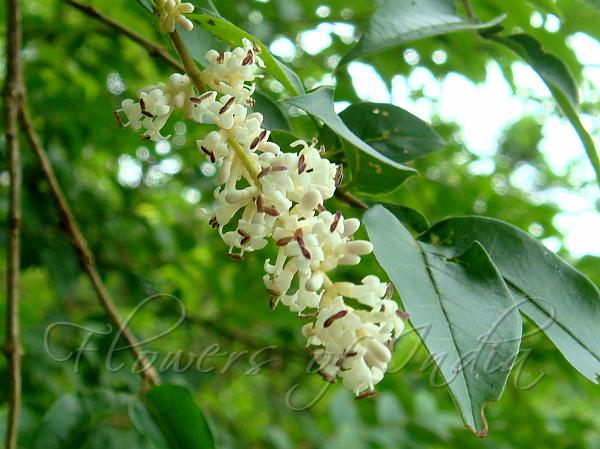|
| Indian Privet |
|

|

| File size | 1431904 |
| Original date | 6/15/08 12:29 PM |
| Resolution | 2048 x 1536 |
| Flash | Flash did not fire, auto |
| Focal length | 6.33mm |
| Exposure time | 1/125s |
| Aperture | 3.5 |
| Focus Distance | |
| Metering Mode | Multi-segment |
| Camera make | SONY |
| Camera model | DSC-T20 |
| Sensor type |
|
|
|
|
Photo: |
Botanical name: Ligustrum confusum Family: Oleaceae (Jasmine family)
Synonyms: Ligustrum kumaonense
Synonyms: Ligustrum kumaonense
Indian Privet is a shrub or small tree up to
8 m. Branchlets are round, finely velvet-hairy when young, becoming
hairless. Leaf-stalks are 4-5 mm, hairless or finely velvet-hairy;
leaf blade ovate to elliptic, sometimes lanceshaped, 2.5-7 x 1.3-3 cm,
thin leathery, hairless, base wedge-shaped to broadly wedge-shaped
or rounded, tip tapering or pointed; primary veins 4-6 on each side
of midrib. Flowers are borne in panicles at branch-ends, 4-11 x 2-8 cm;
axis finely velvet-hairy to velvet-hairy. Flowers are nearly stalkless.
Sepal-cup is 1-1.5 mm, hairless. Flowers are 4-5 mm; tube about as long
as petals. Stamens not exceeding petals, anthers 1-1.5 mm. Fruit is
black or black-brown, almost spherical to obovoid, 6-11 mm in diameter.
Indian Privet is found in thickets near rivers or strean sides, at altitudes
of 800-2100 m, from Himalayas to SE Asia.
Privet was originally the name for the European semi-evergreen shrub
Ligustrum vulgare, and later also for the more reliably evergreen
Ligustrum ovalifolium (Japanese privet), used extensively for privacy
hedging (hence "privet", private). The term is now used for all members of
the genus Ligustrum. Flowering: June-July.
| Identification credit: Navendu Pāgé, Tabish, Saroj Kasaju | Photographed at Leimaraam, Manipur. |
• Is this flower misidentified? If yes,